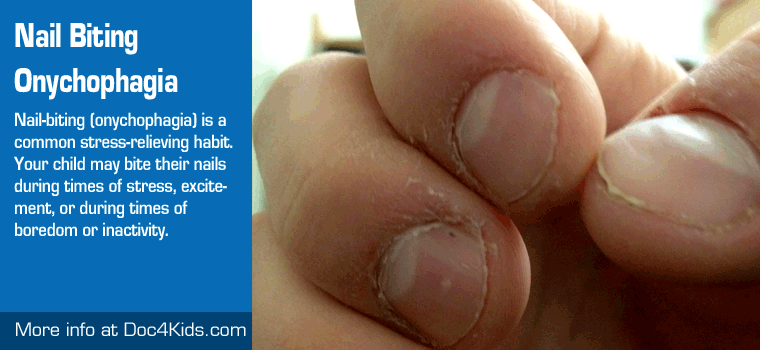Nail Biting Onychophagia
Nail-biting (onychophagia) is a common stress-relieving habit. Your child may bite their nails during times of stress, excitement, or during times of boredom or inactivity. Nail-biting can also be a learned behavior from family members. Nail-biting is the most common of the typical “nervous habits,” which include thumb-sucking, nose-picking, hair-twisting or hair-pulling, tooth-grinding, and picking at skin.
Your child may bite their nails without realizing they are doing it. Your child might unintentionally bite their nails without thinking about it while being involved in other activities, such as reading, watching television, or talking on the phone. Nail-biting includes biting the cuticle and soft tissue surrounding the nail as well as biting the nail itself. Children may bite their nails more often when they are having problems at school or with friends. So, talk with your child or his or her teacher about any new stress at school.
Children are more likely to stop biting their nails when they understand what may trigger it. It is also important for your child to help choose a treatment method so he or she can use the treatment successfully. Nail-biting may occur with other body-focused repetitive behaviors (BFRB) such as hair-pulling or skin-picking.
Who Bites Their Nails?
- About half of all children between the ages of 10 and 18 bite their nails at one time or another. Nail-biting occurs most often as teens are going through puberty changes.
- Some young adults, ages 18 to 22 years, bite their nails.
- Only a small number of other adults bite their nails. Most people stop biting their nails on their own by age 30.
- Boys bite their nails more often than girls after age 10.
What Treatments Are Available For Nail-biting?
Several treatment measures may help stop your child from biting their nails. Some focus on behavioral changes and some focus on physical barriers to nail-biting.
- Keep the nails trimmed and filed. Taking care of the nails can help reduce nail-biting habit and encourage your child to keep their nails attractive.
- Have a manicure regularly (for older children) or use nail polish. Wearing artificial nails may stop an adolescent from biting their nails and protect them as they grow out.
- Try stress-management techniques if the child bites their nails because they are anxious or stressed.
- Paint a bitter-tasting polish, such as CONTROL-IT® or THUM®, on the nails. The awful taste will remind your child to stop every time they start to bite their nails.
- Try substituting another activity, such as drawing or writing or squeezing a stress ball or Silly Putty, when you find your child biting their nails. If you keep a record of nail-biting, you will become more aware of the times when your child bites their nails. This can help to stop the habit.
- Wear gloves, adhesive bandages, or colored stickers whenever possible to remind your child not to bite your nails.
- Snap a rubber band on the inside of their wrist when they start to bite their nails so they have a negative physical response to nail-biting.
What Problems Can Develop From Nail-biting?
Nail-biting can cause the fingertips to be red and sore and the cuticles to bleed. Nail-biting also increases the risk for infections around the nail beds from being in your child’s mouth.
Long-term nail-biting can also interfere with normal nail growth and cause deformed nails.
Rarely, nail-biting may be a symptom of obsessive-compulsive symptoms which can be usually treated with medicines.

